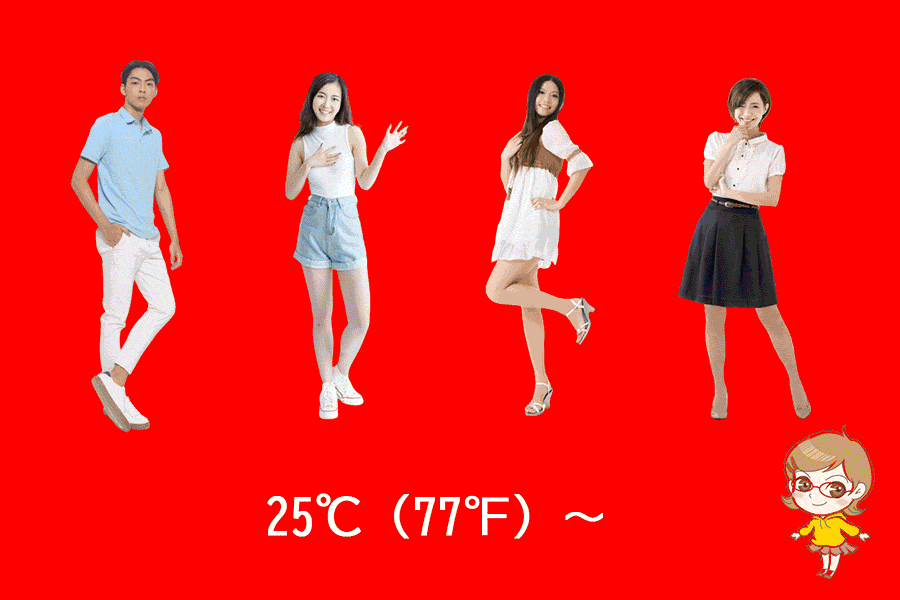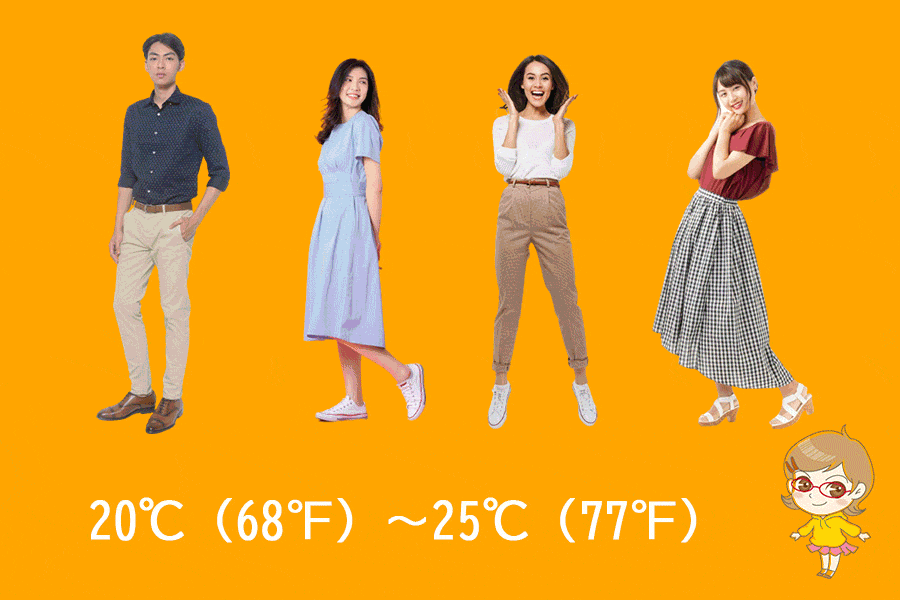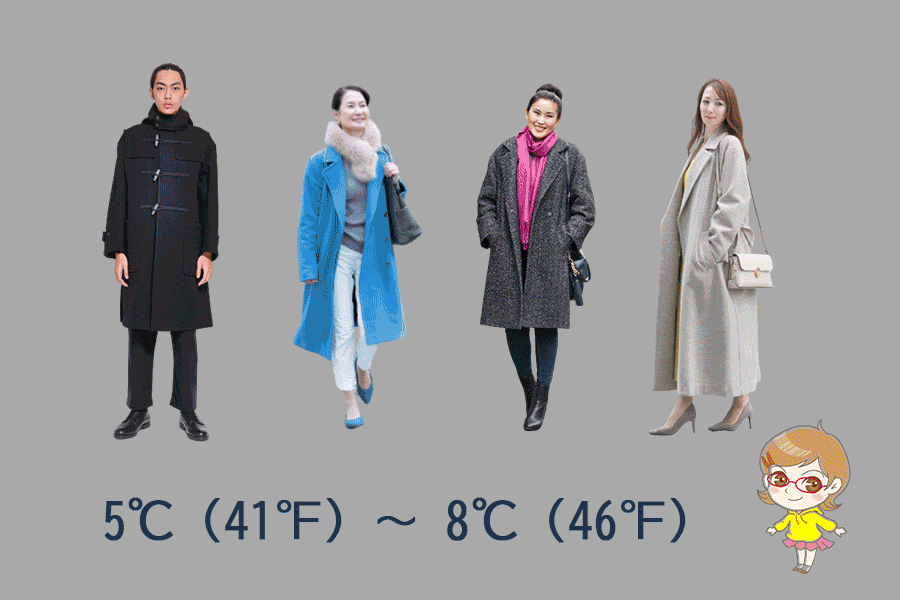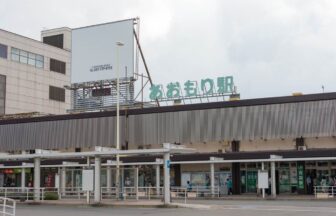1 Omotemachi, Hirosaki, Aomori 036-8096 MAP
↓ Click to jump to the relevant section.
| Current Weather | Annual Weather | Tourist Attractions |
| Baggage Deposit | Hotels |
Current weather and clothing

The weather information shown here is the information closest to the station in question. Please note that there may be slight differences.
Yearly temperature changes and recommended clothing
Clothing recommendations for each temperature range
When traveling in Japan with the following average temperatures, the recommended clothing is as follows:
Monthly changes in temperature, precipitation, and snowfall (1991~2020 average, Japan Meteorological Agency survey)
| Jan. | Feb. | Mar. | Apr. | May | Jun. | Jul. | Aug. | Sep. | Oct. | Nov. | Dec. | |
| temperature(°C) | -1.5 | -1 | 2.3 | 8.6 | 14.3 | 18.3 | 22.3 | 23.5 | 19.4 | 12.9 | 6.5 | 0.8 |
| precipitation(mm) | 125.5 | 99.9 | 82.3 | 65.8 | 66.3 | 71.9 | 115.3 | 140.7 | 136.3 | 107.7 | 113.7 | 130.1 |
| snowfall(cm) | 221 | 185 | 116 | 6 | 0 | 0 | 0 | 0 | 0 | 0 | 17 | 147 |
Winter
December
December is the coldest month of the year, with an average temperature of 0.8°C. Snowfall continues, so you’ll want to wear warm winter clothing, including a coat, boots, gloves, and a hat.
January
It is very cold in January, with an average temperature of -1.5°C. The temperature drops below freezing at night, so be sure to wear a thick winter coat, gloves, and a scarf to protect yourself from the cold.
February
It is still cold in February, with an average temperature of -1°C. Snow is still common, so you’ll want to wear a thick winter coat, boots, and gloves.
Spring
March
March is a bit warmer than the previous two months, with an average temperature of 2.3°C. However, it can still be cold and windy, so it’s a good idea to wear a winter coat, hat, and gloves.
April
April is a transition month, with temperatures warming up to an average of 8.6°C. It’s still a bit chilly, so a light jacket or sweater may be necessary. You may also want to bring an umbrella, as there can be some rainfall in April in Hirosaki.
May
May is much milder than the previous months, with an average temperature of 14.3°C. You’ll want to wear a light jacket or sweater during the day, and a warmer layer at night.
Summer
June
June is the rainy season It’s also the start of summer, with an average temperature of 18.3°C. You’ll want to wear light clothing that dries quickly, like a raincoat or jacket, and waterproof shoes.
July
July is the hottest month of the year, with an average temperature of 22.3°C. It’s important to stay cool and hydrated during this time, so you’ll want to wear light, breathable clothing like shorts, t-shirts, and sandals.
August
August is also very hot, with an average temperature of 23.5°C. You’ll want to wear light clothing and sandals, and be sure to use sunscreen and stay hydrated.
Autumn
September
September is a transition month, with temperatures starting to cool down to an average of 19.4°C. It’s a good idea to bring a light jacket or sweater, as the nights can be chilly.
October
October is another transition month, with temperatures dropping further to an average of 12.9°C. You’ll want to wear a light jacket, long-sleeved shirt, and pants to keep warm.
November
November is the beginning of the snowy season, with an average snowfall of 17cm. The average temperature is 6.5°C, so you’ll want to wear a winter coat, boots, gloves, and a hat to protect yourself from the cold.
Recommended tourist destinations
Hirosaki Castle
1-1 Shimoshirogane-cho, Hirosaki, 036-8356 Aomori Prefecture
Built in 1611, this historic castle is a well-preserved example of Japanese architecture. The park surrounding the castle is famous for its cherry blossoms, attracting visitors from around the world.
Hirosaki Park
1-1 Shimoshirogane-cho, Hirosaki, 036-8356 Aomori PrefectureThis large park, with its magnificent cherry blossoms, seasonal flowers, and children’s playground, attracts many tourists during the Hirosaki Cherry Blossom Festival, which takes place from late April to early May.
Fujita Memorial Garden
8-1 Kamenokomachi, Hirosaki 036-8207 Aomori Prefecture
A traditional Japanese garden featuring a beautiful pond and tea house. Visitors can enjoy a relaxing stroll through the carefully manicured landscape.
Hirosaki Apple Park
125 Shimizutomita Terasawa, Hirosaki 036-8262 Aomori Prefecture
A vast park dedicated to apple cultivation, where visitors can enjoy fruit picking, tastings, and a variety of seasonal events.
Nebuta Museum Wa Rasse
1-1-1 Yasukata, Aomori 030-0803 Aomori Prefecture
A cultural museum showcasing the history and artistry of the Aomori Nebuta Festival. Visitors can experience the colorful floats and learn about the festival’s traditions.
Sannai-Maruyama Site
305 Sannai-Maruyama, Aomori 038-0031 Aomori Prefecture
An important archaeological site featuring the remains of a large prehistoric Jomon settlement. The site offers a unique opportunity to learn about Japan’s ancient history.
Hakkoda Ropeway
1-12 Arakawa, Aomori 030-0111 Aomori Prefecture
A scenic ropeway offering breathtaking views of the Hakkoda Mountains and surrounding landscape. Popular for hiking in summer and skiing in winter.
Oirase Gorge
Okuse, Towada 034-0301 Aomori Prefecture
A picturesque river gorge with cascading waterfalls and lush forests, perfect for leisurely walks or more adventurous hikes.
Lake Towada
486 Okuse Towadakohan Yasumiya, Towada 018-5501 Aomori Prefecture (Towada Visitor Center)
A stunning caldera lake offering scenic boat rides and a variety of hiking trails. The surrounding nature is particularly beautiful during autumn when the leaves change colors.
Shirakami-Sanchi
Nishimeya-mura, Nakatsugaru-gun, Aomori, Japan
A UNESCO World Heritage site, this pristine mountain range is home to virgin beech forests and an extensive network of hiking trails, drawing nature enthusiasts from across the globe.
Where to leave your luggage
There are two locations: the first coin locker is located near the central entrance on the first floor, and the second is next to the Tourist Information Center in the station. A full range of small, medium, and large coin-operated lockers are available.
Recommended hotels and inns
Art Hotel Hirosaki City
1-1-2 Omachi, Hirosaki 036-8004 Aomori Prefecture
2-minutes walk from Hirosaki Station
Hotel class: 4.5
Hotel style: Mid-range, Centrally Located
Check Rates & Availability:
>> See on Tripadvisor
>> See on Trip.com
>> See on Expedia
Hotel Route Inn Hirosaki Ekimae
5-1 Ekimaecho, Hirosaki 036-8003 Aomori Prefecture
2-minutes walk from Hirosaki Station
Hotel class: 3
Hotel style: Centrally Located
Check Rates & Availability:
>> See on Tripadvisor
>> See on Trip.com
>> See on Expedia
Dormy Inn Hirosaki
71-1 Honcho, Hirosaki 036-8203 Aomori Prefecture
18 minutes walk from Hirosaki Station
Hotel class: 3
Hotel style: Business, Charming
Check Rates & Availability:
>> See on Tripadvisor
>> See on Trip.com
>> See on Expedia
Toyoko Inn Hirosaki Ekimae
1-1-1 Ekimae, Hirosaki 036-8002 Aomori Prefecture
1-minute walk from Hirosaki Station
Hotel class: 3
Hotel style: Centrally Located, Business
Check Rates & Availability:
>> See on Tripadvisor
>> See on Trip.com
>> See on Expedia
Hirosaki Park Hotel
126 Dote-machi, Hirosaki 036-8182 Aomori Prefecture
10 minutes walk from Hirosaki Station
Hotel class: 3
Hotel style: Great View, Centrally Located
Check Rates & Availability:
>> See on Tripadvisor
>> See on Trip.com
>> See on Expedia
Blossom Hotel Hirosaki
7-3 Ekimae-cho, Hirosaki 036-8003 Aomori Prefecture
10 minutes walk from Hirosaki Station
Hotel class: 3
Hotel style: Business, Quaint
Check Rates & Availability:
>> See on Tripadvisor
>> See on Trip.com
>> See on Expedia
Hirosaki Plaza Hotel
101-1 Daikan-cho, Hirosaki 036-8001 Aomori Prefecture
8 minutes walk from Hirosaki Station
Hotel class: 3
Hotel style: Business
Check Rates & Availability:
>> See on Tripadvisor
>> See on Trip.com
>> See on Expedia
Hirosaki Grand Hotel
1 Ichiban-cho, Hirosaki 036-8201 Aomori Prefecture
5 minutes walk from Hirosaki Station
Hotel class: 3
Hotel style: Business
Check Rates & Availability:
>> See on Tripadvisor
>> See on Trip.com
>> See on Expedia
We support your itinerary planning!
Click the button to get an overview of hotel information and popular tourist routes from all over Japan featured on our site. We’ve included comprehensive details to aid in planning your trip, so please make use of it.
Comprehensive checklist before traveling to Japan

Book flights
Compare and purchase flight tickets
When planning your trip to Japan, it's advisable to start by researching flights several months in advance. Airlines often release promotional fares, especially during off-peak seasons. Use comparison sites like Skyscanner or KAYAK to get a sense of the price range. Be flexible with your travel dates if possible; flying mid-week might be cheaper than on weekends.
>> Visit Skyscanner's official website
>> Visit KAYAK's official website
Order Japan Rail Passes for each family member
Purchase your Japan Rail Pass before departure
The Japan Rail (JR) Pass offers unlimited travel on JR trains, making it a cost-effective option for tourists. However, it's only available to foreign tourists and must be purchased *before* you arrive in Japan. Determine the areas you plan to visit; if you're traveling extensively, a nationwide pass is beneficial, but if you're only exploring a specific region, consider regional JR passes. Children under 12 get a discounted pass, so ensure you order the correct type for each family member.
>>Visit Japan Rail Pass's website
Plan your attire for Japan
Check the weather at your destination on this site
Japanese weather varies significantly by season. In summer, it's hot and humid, so breathable clothes are essential. Winters, especially in the north, can be cold, requiring warm attire. If visiting during the rainy season (June to early July), pack a good umbrella and waterproof shoes. While Japan is generally casual, certain places like temples, shrines, or upscale restaurants may require modest and neat dressing.
Reserve a pocket Wi-Fi or SIM card

SIM card or pocket Wi-Fi is required
Beyond clothes, consider packing essentials like a universal power adapter (Japan uses Type A and B sockets), portable Wi-Fi or SIM card for internet access, and any necessary medications (with a copy of the prescription).
Which is better: a SIM card or pocket Wi-Fi?
When traveling in Japan, one essential to consider is securing internet access, especially given that many locations still don't offer free Wi-Fi. To ensure you can use your smartphone throughout your trip, you'll typically have three options: (1) a SIM card, (2) pocket Wi-Fi, or (3) the roaming service provided by your mobile company. Roaming services can be quite expensive, so we often recommend using a SIM card or pocket Wi-Fi. While SIM cards tend to be more affordable than pocket Wi-Fi, they can be trickier to set up. Pocket Wi-Fi, on the other hand, can be shared among several users, making it a favorable choice for families or groups.
▼SIM card
Advantages:
Relatively affordable.
Disadvantages:
Can be time-consuming to set up initially.
May have strict data limits.
▼Pocket Wi-Fi
Advantages:
Offers substantial data allowances.
A single device can be shared among multiple users.
Easily usable with PCs as well.
Disadvantages:
Typically more expensive.
Japan's representative services

Sakura Mobile's website
▼SIM card
>>Visit Sakura Mobile's official website
>>Visit mobal's official website
▼pocket Wi-Fi
>>Visit Sakura Mobile's official website
>>Visit NINJA WiFi's official website
>>Visit Wi-Fi RENTAL Store's official website
Book local tours as needed
Pre-book your tour and have a great trip!
Local tours offer deep insights into Japan's culture and heritage. Websites like Viator or GetYourGuide offer a variety of tours, from traditional tea ceremonies to modern pop culture tours in Akihabara. Consider unique experiences like staying with monks on Mt. Koya or taking a cooking class to learn authentic Japanese dishes.
>>Visit Viator's official website
>>Visit GetYourGuide's official website
Purchase advance tickets for popular attractions
Make a reservation to avoid crowds
Attractions like Tokyo Disneyland, Universal Studios Japan, or the Studio Ghibli Museum often have long ticket queues. Buy tickets online in advance to save time. Some attractions also have timed entry, so check the specific time slots available and plan accordingly.
▼Tokyo Disney Resort
>>Visit Tokyo Disney Resort official website
>>Visit Viator's Tokyo Disneyland page
>>Visit Viator's Tokyo DisneySea page
>>Visit GetYourGuide's Tokyo Disneyland page
>>Visit GetYourGuide's Tokyo DisneySea page
▼Universal Studios Japan
>>Visit USJ official website
>>Visit Viator's USJ page
>>Visit GetYourGuide's USJ page
Buy travel insurance

insurance concept, health, life and travel insurance
It is important to be prepared for emergencies
While Japan is a safe country, travel insurance is crucial for unforeseen events like health emergencies, travel disruptions, or lost baggage. Ensure your policy covers medical expenses in Japan, as healthcare, though excellent, can be expensive.
Here we introduce online travel insurance services that are popular worldwide.
World Nomads: An online travel insurance service widely endorsed by travelers worldwide. They offer plans that cover adventurous activities and high-risk sports.
>>Visit World Nomads' official website
AIG Travel Guard: An insurance service available to travelers all over the world. They offer a wide range of options, including cancellation protection and emergency medical insurance.
>>Visit AIG Travel Guard's official website
Share your itinerary with emergency contacts
Organize your reservation information
Keep a digital and printed copy of your detailed itinerary, including hotel addresses, train schedules, and booked tours. Share this with a trusted family member or friend not traveling with you.
















